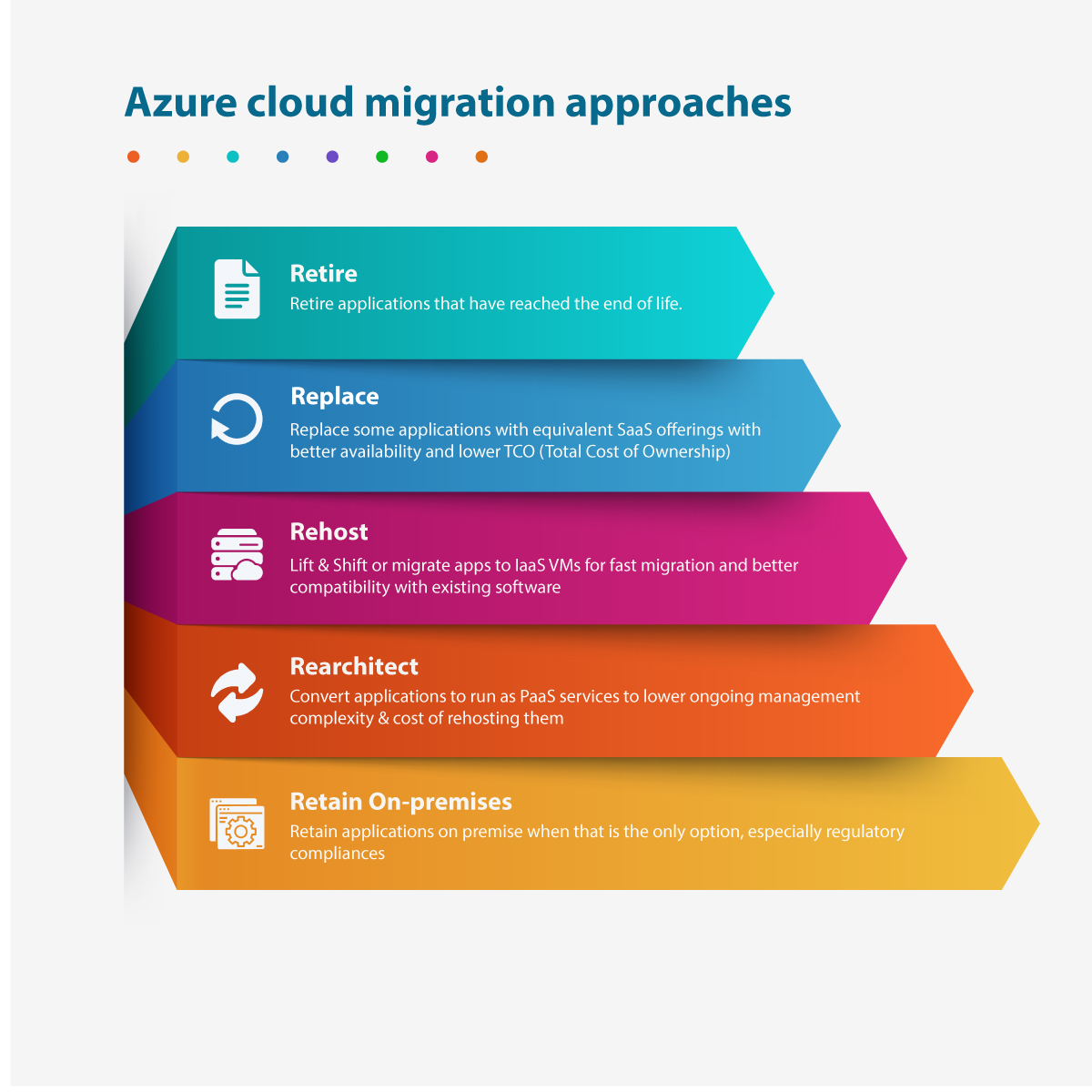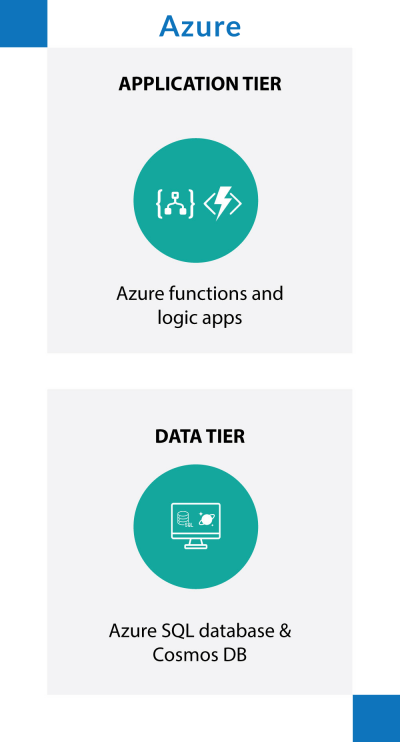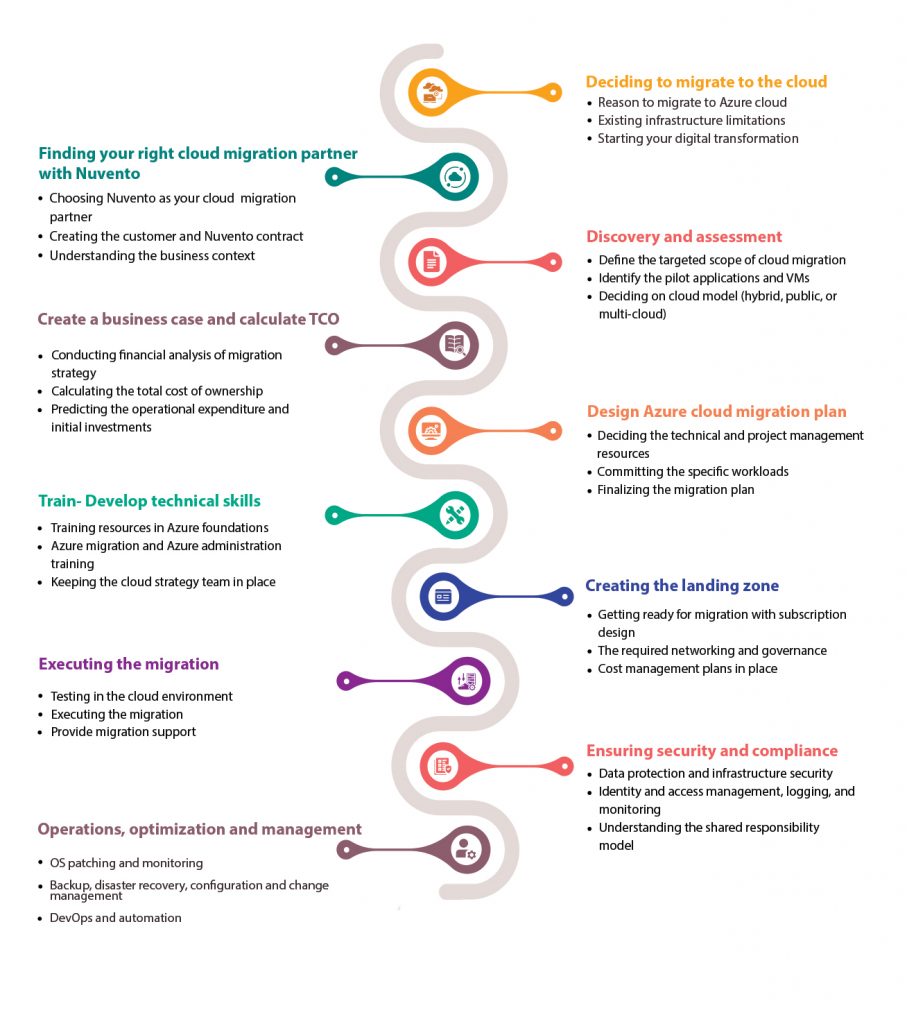
06 Jan 4 Step Strategy to Azure Cloud Migration
4 Step Strategy to Azure Cloud Migration
Organizations need to be agile and resilient when faced with unexpected challenges, such as the one that we are facing today with the global pandemic.
Moving to Azure allows you to innovate in new ways with the adoption of a cloud-based operations model on infrastructure as a service (IaaS) technology. You can also take advantage of further opportunities to innovate by modernizing with a platform as a service (PaaS) offering that is fully managed.
Why migrate to Azure?
Azure gives you the agility and resilience to take advantage of new opportunities and thrive amidst new challenges by moving to the cloud.
Enterprise-grade infrastructure on a budget
- With a cloud operational expense (OPEX) model, you can better manage your cash flow and respond faster to business changes. Azure lets you get the most value from your Azure investment. The key guidance from Azure and best practices from the organization help you choose the best short- and long-term cloud solutions for your needs.
- With Azure you can get extended security updates for three more years at no additional changes on Windows Server 2012 R2 and SQL Server 2012 R2.
- Azure’s built-in high availability and disaster recovery options help to mitigate business disruptions for maximum resilience.
- Forrester Consulting has found that a composite organization can avoid US$10m in on-premises infrastructure and staff costs and experience a 473% 3-year RoI.
Fully managed platform lets you innovate faster
- Azure’s built-in scalability, high availability, enterprise-grade SLA and cost optimization options by modernizing .NET, PHP and Java websites and apps to fully managed PaaS services like Azure App Service and Azure Spring Cloud.
- Containerizing your existing apps to accelerate app development cycles, simplify deployment and quickly scale. You can leverage Azure Container Service (AKS) or use Azure Migrate to containerize your .NET and Java applications.
- Modernize the backend of your .NET, Java and Linux apps with fully managed Azure SQL, Azure Database for MySQL and Azure Database for PostgreSQL.
Trusted cloud security that protects your valuable assets
- Over 3500 global security experts and Azure’s US$1billion investment in cybersecurity help to safeguard your business.
- The broadest set of cloud compliance certifications helps to confidently meet your regulatory requirements.
- Leverage intelligent, AI-informed security analytics with Azure Sentinel – a cloud-native SIEM that helps to secure your organization from threats.
Azure’s hybrid flexibility allows you to move your assets
- Use Azure Arc to manage, secure and govern your Linux, Windows and SQL workloads that you are not ready to move yet or want to move at a later time.
- Run apps on Azure or use on-prem Arc-enabled Kubernetes to enable consistent app development and improved velocity in hybrid environments.
- With Azure Hybrid Benefit, you can reuse your existing Windows Server and SQL Server licenses on the cloud.
That said, let’s now see the Azure cloud migration steps
While the first step to Azure Migration is developing your “Own Azure Migration Strategy”, Microsoft Azure then recommends dividing the migration into four key steps:
- Assess
- Migrate
- Optimize
- Secure and Manage
You can also start off with the Azure migration checklist for a high-level walk-through of the cloud adoption process. Learn about offers and resources that can help to offset costs and accelerate your cloud move.
Assess
There are a few key components that are critical to the success of this step. Discovery, mapping and evaluation of on-premise applications.

- Discovery: Using cloud migration assessment tools, compile and inventory of the physical and virtual servers in your environment. Also put together information about the performance of applications. Once this step is done, you will be ready with the inventory of servers and their metadata, with which you can build your cloud migration plan.
- Mapping on-premise applications: With the information from discovery, map your servers to show suitability to on-premises applications. This step helps to identify dependencies or communication between servers so you can include all necessary all relevant application components in your cloud migration plan. Logically group servers to represent applications, and go for a migration strategy for each application based on its requirements and objectives.
- Evaluating: Once your application groups are mapped, you can now identify the best paths for migration. With this evaluation, you also see how each application you currently have runs on Azure and can estimate the cost to run it. Using cloud migration assessment tools will help you to evaluate paths for the migration process and recommend Azure resources and migration strategies for application servers.
Migrate
You can migrate to Azure through any of the 4 approaches: rehost, refactor, rearchitect and rebuild.
Rehost: Move your applications to Azure without any changes to the code. This method is often called “lift-shift” migration. In this step, you need to ensure that your applications do not need any code changes and can be directed hosted on the Azure platform.
When to use:
- To achieve a rapid time to cloud and faster migration.
- Need the least impact on architecture and code.
- To free up data centers quickly.
- To leverage existing investments.
- Reduce capital expenditure for existing apps
The primary technology used: IaaS and DBaaS
Pros: With this strategy, users to migrate quickly and easily with lesser application breakdown issues.
Cons: Application may not fully leverage the Cloud resources.

Refactor: Make changes to your existing applications for maximum efficiency. You also need to make them compatible with Microsoft products in the cloud. This method does not change the code of the application, but will let you take advantage of Azure IaaS and PaaS products.
When to use:
- Cost-effectively meet scalability requirements of existing apps.
- To enable business agility with continuous innovation
- To leverage the existing investments
The primary technology used: IaaS, PaaS, Containers
Pros: This is a fast way to improve your infrastructure.
Cons: It is not possible to make major changes to the application infrastructure.

Rearchitect: Make modifications to the application codebase so that it is a fit for the Azure environment. With fundamental code changes are made, your app is made ready for the latest Azure products and modifications, while retaining the value gained from the original application itself.
When to use:
- To meet the scalability requirements of existing apps cost-effectively.
- To use continuous innovation to enable business agility
- To leverage existing investments in business
- To make integration with other cloud and web apps easier
The primary technology used: IaaS, PaaS, Containers, Serverless
Pros: You can reach scalability requirements cost-effectively. Applications can leverage Azure capabilities and agility can be improved.
Cons: Complex and expensive. Migration involves a high risk of faults and service disruption.

Rebuild: Rebuild applications using cloud-native products. When you eliminate applications that are too old or outdated to function in the cloud, this is the best approach to follow.
When to use:
- To easily integrate with other web and cloud apps
- To enable multi-channel access through mobile and IoT
- To deliver new and advanced capabilities faster
The primary technology used: PaaS, Serverless
Pros: There is no complexity of software licenses, middleware, and existing resources.
Cons: Decreased level of functionalities in custom-made apps.


Once you evaluate your existing applications, you may decide on one or a combination of these migration methods to meet your business needs. You need to know that there is no one-size fits all approach.
Using the services of a cloud managed service provider, you can identify the best approach for your business and kick-start your application migration journey.
Azure migration tools
- Azure Migrate: Lift and shift is the easiest option for moving applications and data to the cloud. That makes it the preferred migration strategy when customers kickstart their migration journey. Two services offered by Azure Migrate for migrating servers are Azure Migrate: Discovery & Assessment and Azure Migrate: Server Migration.
- Azure Data Migration Services: Host your databases on Azure’s PaaS and IaaS options. Azure Data Migration Assistant (DMA) and Azure Database Migration Service (DMS) assist in this process through the assessment of existing databases, recommending remediations where needed and enabling migrations.
- SQL Server Migration Assistant: Use SQL Server Migration Assistant (SSMA) when you have different database platforms to migrate data to SQL server or Azure Synapse Analytics. The supported source platforms include Microsoft Access, MySQL, Oracle, SAP ASE, and DB2 databases.
- Azure Synapse Pathway: A database can include thousands of lines of code written over the course of many years, requiring time and cost investments to translate. With Azure Synapse Pathway, you can address this challenge through automated code translation to enable migrating existing data warehouses to Azure Synapse Analytics.
- Azure Backup and Site Recovery: Azure Backup is the cloud-based backup solution that can be used for taking backup of data from different sources like on-premises servers, Azure VMs, managed disks, Azure file shares, and more.
Optimize
Finetune your cloud experience to make sure you are making the most of all that Azure has to offer. There are a few steps you can follow to optimize your cloud experience.
- Keep track of costs: Use Azure Cost Management tool to understand where you need to increase or reduce cloud usage. When you have transparency over where your resources are spent, you can financially prepare for any next steps in the cloud journey. Leverage unique offerings like Azure Hybrid Benefit and Azure Reserved Virtual Machine Instances to fit in workloads.
- Maximize value with reinvestments: Once you get returns in the form of time and resources that are no longer used, reinvest them into innovations and projects within your organization and maximize the value of your cloud transformation.
Secure and Manage
To maintain strict security and maintenance across all applications, use Microsoft products that assist in security, backup and full-time monitoring of your cloud application. This keeps your business running at maximum capacity.
- Azure Security Center: Get effective cloud security management and advanced threat protecting for your cloud workloads. With Azure Security, you can additional protection, giving you full visibility and control over cloud applications’ security. You also leverage benefits like increased threat detection and recovery rates.
- Azure Backup: Backup apps in Azure to avoid potential security threats, additional costs and business disruptions, while ensuring compliance.
- Azure Monitor: Monitor and track the health of your cloud data, apps and other infrastructure, alongside providing the right insights and analytics.
Other considerations
While a shift to the cloud is just what your business probably needs to get to its success, there are a few things to consider before you jump head-first into the cloud.
- Check compliances: Organizations must ensure they keep up with global compliance requirements. It is the responsibility of the organization to maintain legal compliance, so before you begin your cloud venture, make sure your organization has met all required standards that are required for your industry so your migration to the cloud is a breeze.
- Contractual agreements: Read through all contractual agreements to fully understand not just the opportunities that lie ahead, but to also know what you could be getting into. Go through all conditions mentioned before committing, no matter which provider you use.
- Understand your business’s unique cloud needs: Your cloud strategy should be as unique as your business. Assess the health of your organization as you plan your migration to ensure you’re making decisions that benefit you in the long run.
- Consult with an expert: Cloud migrations are not simple! To make the most of your investments, reach out to a trusted cloud service provider who can guide you in your journey to the cloud. Certified Microsoft Partners have the skills and experience to help you as you begin your journey and beyond.
While the above gives you a high-level of how to plan your cloud migration journey, the actual journey will need a whole lot of personalization. If you’d like to know more, you can schedule a free cloud assessment with our experts to know just how you can make a move from your on-prem infrastructure or other cloud infrastructure to Azure.
Developing your azure cloud migration strategy – Important questions to ask yourself
Migrating to the cloud is a big business move and you need a solid cloud migration strategy before you start. The best way to do that is to ask yourself questions for each migration stage and prepare your azure cloud migration roadmap based on the answers.
Assess and plan
In the assessment and planning stage, you need to assess your current infrastructure, create a strong business case for your Azure cloud migration and define your cloud migration goals. Here are some of the questions that you can ask at this stage?
- What are the specific benefits of migrating this workload to the cloud?
- Which workloads should be moved to the cloud and how should we do it?
- How much does it cost to move to the cloud?
- How long is it going to take to migrate to the cloud with Azure?
- Should I go for the public, hybrid, or multi-cloud model?
Migrate
The migration stage involves the actual moving of applications, workloads, and data. You need to ensure that you have enough technical resources and a system to do the migration. In this Azure cloud migration step, you need to lay the network, create Azure resources, and select the target platform. Some of the key questions to ask at this stage are,
- How can I move without affecting any critical functionalities?
- How am I going to test whether the workloads are compatible with the cloud?
- How do I ensure data security during migration?
- How the migration will be monitored and verified?
Modernize
To take full advantage of the Azure cloud, you need a platform-based architecture. Azure app services, microservices, containers, cloud-native application designs, etc. are the considerations in modernizing applications. Here, you need to explore the possibilities for applications and data and ask yourself the following questions,
- Which applications can be modernized?
- How do I rebuild applications to make full use of cloud capabilities?
- How can I utilize PaaS services to get all the benefits of the cloud?
- How can I analyze the data and make use of it?
- What is the fail-back strategy?
Optimize and manage
Once the migration is complete and the workloads are stable, you can optimize your cloud usage based on cost, performance, and ROI. There are many features like Azure Subscriptions, Azure cost management, reservations, automatic VM shutdowns, autoscaling, etc. from Azure which can be used for optimizing and managing your cloud usage.
- How do I right-size cloud for my needs and lower operational costs?
- How do I increase productivity and generate greater ROI?
- How can I use data and insights to make informed decisions?
Your Azure cloud migration journey
The journey to the cloud is different for every business and it is not linear. This is why we develop an Azure cloud migration roadmap for every customer based on their specific business cases and requirements. We have to optimize at every stage of the migration. Let us look at the typical cloud migration journey of a customer with Nuvento.

